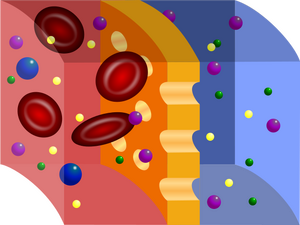Dialysis of Solutions
Macromolecular substances (e.g. proteins, polysaccharides, nucleic acids) in solution can be separated from inorganic salts and other low-molecular substances using natural or artificial semipermeable membranes, k which allow free passage of small molecules, while large molecules do not pass through this membrane. This process of differential diffusion is called dialysis.
The principle of the Method[edit | edit source]
Small molecules diffuse across the membrane in the direction of concentration gradient. As soon as the concentrations of small molecules on both sides of the membrane equalize, the system reaches a steady state (i.e. molecules do not diffuse across the membrane perceptibly - or more precisely, the rate of diffusion in both directions is the same).
If it is necessary to speed up the process, or to completely remove a substance from the dialyzed solution, a sufficient concentration gradientconcentration gradient. must be maintained throughout the process . Either a large amount of dialysis solution is used (relatively – in relation to the volume of the dialyzed solution), or the dialysis solution is changed frequently (before the concentrations of small molecules in the dialysate and the dialysis solution are equalized). The speed of dialysis is also dependent on the area of the dialysis membrane: the larger it is, the faster small molecules pass through.
An important feature of each dialysis membrane is its so -called cut-off value (MWCO – molecular weight cut-off). (MWCO – molecular weight cut-off ). It informs about how large molecules the membrane considers small (i.e. it will allow them to pass freely) and which are already large (i.e. they will not pass through the membrane). Most molecules with a molecular weight exceeding the MWCO of a given membrane should be retained by that membrane. This parameter must be taken with a grain of salt, not only the overall size of the molecule, but also its shape plays a role here.
You also won't be able to go through the door with the umbrella open, but if you fold it down, you shouldn't have any trouble entering the room. At the same time, it is still the same umbrella.
Clinical Use[edit | edit source]
In a living organism, all cell membranes or their organelles can also be described as semipermeable, as they allow the passage of water and low-molecular substances, but not proteins, to a certain extent. In the research laboratory, dialysis is a simple alternative if, for example, it is necessary to remove excess salts from a solution of proteins (or other macromolecular substances) or to transfer proteins to another buffer.
In clinical medicine, one of the methods of treating kidney failure is calledhemodialysis, as it is based on exactly the same principle: the patient's blood flows around semi-permeable membranes, which allow the concentration of low-molecular substances to be equalized with the dialysis solution on the other side of the membrane (and therefore the removal of waste products of metabolism). while plasma proteins and blood cells do not pass through the dialysis membrane and are not lost. In addition to artificial membranes located outside the patient's body, the patient's peritoneum can also be used for hemodialysis - in this case, the peritoneal cavity is washed with a dialysis solution, we are talking about peritoneal dialysis.
It is important to note that not every small molecule is a waste product. It is therefore necessary to pay for the molecules lost in this way. For example, glucose, Na + , K + etc. are added to the dialysis solution .

